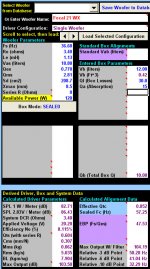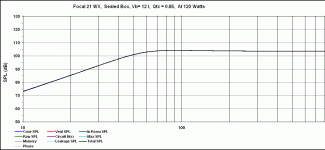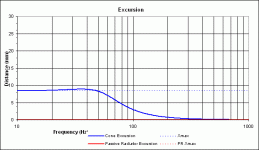Hi and thanks for reading this post
I've been offered a pair of speakers which are rated at 300 watts rms each.
Unfortunatly I've been advised not to buy them, as i listen to music at a lowish volume, usually 20-30 watts per channel and was told at that volume the speakers would not sound good, that these speakers probably have a big voice coil that needs a lot of watts to warm it up.
What do you think, is this true, i thought a higher wattage rating just meant the speaker could handle more power.
Many thanks.
I've been offered a pair of speakers which are rated at 300 watts rms each.
Unfortunatly I've been advised not to buy them, as i listen to music at a lowish volume, usually 20-30 watts per channel and was told at that volume the speakers would not sound good, that these speakers probably have a big voice coil that needs a lot of watts to warm it up.
What do you think, is this true, i thought a higher wattage rating just meant the speaker could handle more power.
Many thanks.
If they are home speakers, very few people listen using more than a couple watts of power. The idea that a speaker needs a warm coil to sound good is not true.
Some speakers optimized for high power handling will have heavy cone assemblies and long coils and be really inefficient. These (usually car woofers) may need 4-6x more power to sound the same as a speaker with a lighter cone.
Tell us what they are and you'll get a better answer...
Some speakers optimized for high power handling will have heavy cone assemblies and long coils and be really inefficient. These (usually car woofers) may need 4-6x more power to sound the same as a speaker with a lighter cone.
Tell us what they are and you'll get a better answer...
Sorry to be vague with the details.
The speakers are car speakers, the focal 21 wx be
Here are the specs
Nominal power 250 W
Sensitivity (2.83V/m) 86.5 dB
Cone Surround Rubber
Nom. impedance 4 ohm
DC resistance 3.4 ohm
VC diameter 50 mm
VC height 25 mm
Former Aluminum
Layers 2
Wire Copper
inductance 1.13 mH
Xmax 8.5 mm
Magnet (12 units) 15x45 mm
Magnet weight 1.3 kg
Flux density 0.85 T
Gap height 8 mm
Net weight 4 kg
The cabinet volume is 0.75 cubic feet
Many thanks
The speakers are car speakers, the focal 21 wx be
Here are the specs
Nominal power 250 W
Sensitivity (2.83V/m) 86.5 dB
Cone Surround Rubber
Nom. impedance 4 ohm
DC resistance 3.4 ohm
VC diameter 50 mm
VC height 25 mm
Former Aluminum
Layers 2
Wire Copper
inductance 1.13 mH
Xmax 8.5 mm
Magnet (12 units) 15x45 mm
Magnet weight 1.3 kg
Flux density 0.85 T
Gap height 8 mm
Net weight 4 kg
The cabinet volume is 0.75 cubic feet
Many thanks
Your original impression, that there's no clear relationship between a speaker's power rating and sensitivity, which is what you are asking about, is true. The Sensitivity is a way to compare the output of different speakers with the same input. The power is about how much it will take before breaking.
I'd go with your ears, not the specs in terms of how you listen.
Having said that, the Focal is a very expensive woofer. In terms of return on investment, your friend's advice may make more sense. 8" drivers from other makers would fit the bill. Eton, ScanSpeak, SEAS, SB Acoustics all have very nice 8" woofers in the $200-$300 range, about 1/4th the Focal's list here.
So if your friend was saying that for the money, you are paying for dynamic range you won't use, he was probably accurate. However, if you can afford it, use your ears to decide.
Best,
Erik
I'd go with your ears, not the specs in terms of how you listen.
Having said that, the Focal is a very expensive woofer. In terms of return on investment, your friend's advice may make more sense. 8" drivers from other makers would fit the bill. Eton, ScanSpeak, SEAS, SB Acoustics all have very nice 8" woofers in the $200-$300 range, about 1/4th the Focal's list here.
So if your friend was saying that for the money, you are paying for dynamic range you won't use, he was probably accurate. However, if you can afford it, use your ears to decide.
Best,
Erik
Last edited:
This woofer seems to be a "luxury product" and definitely has a low sensitivity, at "82.63"dB/W (as if it can be controlled that tightly in manufacture 😉 ) perhaps 5-6dB below what some would consider normal.
Just so others don't have to waste their time searching, here is a link:
http://www.alphaaudio.co.jp/images/pdf_folder/focal/ft-21wx.pdf
You'll find better engineered products for 10% of the cost, IMO. That woofer is really nothing special at all, not some sort of "Objet d'art".
Just so others don't have to waste their time searching, here is a link:
http://www.alphaaudio.co.jp/images/pdf_folder/focal/ft-21wx.pdf
You'll find better engineered products for 10% of the cost, IMO. That woofer is really nothing special at all, not some sort of "Objet d'art".
Utopia drivers are very special to those trying to clone Focal Utopia
speakers and in that sense indispensable. All of the Focal drivers
I had played around with were very close to manufacturer's TS
parameters. The Utopias are definitely a luxury product which
doesn't mean extraordinary in a technical sense.
speakers and in that sense indispensable. All of the Focal drivers
I had played around with were very close to manufacturer's TS
parameters. The Utopias are definitely a luxury product which
doesn't mean extraordinary in a technical sense.
As far as I can see though these are the auto line, not home speakers. I'm not sure that the speakers actually correlate in any meaningful sense except the brand anymore. The Be tweeters for instance seem out of the Electra line, unless the Utopia's have also gone with miniature motors.
Personally I'm a fan of their W construction, but for an 8" woofer that seems like extortion.
Best,
Erik
Personally I'm a fan of their W construction, but for an 8" woofer that seems like extortion.
Best,
Erik
It's a subwoofer for a start so you wouldn't need a pair of them as will likely end up in the boot and at that price though you could get a nice Dayton 18" subwoofer (Dayton Audio RSS460HO-4) and an enclosure to put it in.
http://www.parts-express.com/dayton...ies-ho-subwoofer-and-cabinet-bundle--300-7094
http://www.parts-express.com/dayton...ies-ho-subwoofer-and-cabinet-bundle--300-7094
Last edited:
Main point is, you seem toneed these for home use, with a 20/30W RMS amplifier available.
If so, forget it, completely unfit for such use.
besides, did you consider these are SUB woofers?
You can't play music through them, they are but one component of a multi speaker cabinet or installation and to boot need lots of watts driving them, not because of warm coils or whatever but terribly low efficiency, WAY lower than even home bookshelf speakers show (which is already low).
Forget them.
Besides, even the 300W claim is untrue; homepage says 250W "nominal", tht usually means 125W RMS , but worst is horrible magnet design.
First I thought those were Neo disks, but then read they are ferrite cylinders ... lots of space wasted where they shouls have used a solid ring.
Not my prejudice, datasheet shows cheesy 8500Gauss (0.85T) field strength.
Haven't seen such low values for ages, and that only in cheapest of the cheap speakers, today cheap speakers hover around 10000 Gauss (1T) at least.
And they quote two incompatible sensitivity specs: on the simple table meant for the average user, they claim 86.5dB which is low but somewhat usable, but together with the Thiele Small data, used by a Pro, they claim only 82.63dB ... WTF?????
If so, forget it, completely unfit for such use.
besides, did you consider these are SUB woofers?
You can't play music through them, they are but one component of a multi speaker cabinet or installation and to boot need lots of watts driving them, not because of warm coils or whatever but terribly low efficiency, WAY lower than even home bookshelf speakers show (which is already low).
Forget them.
Besides, even the 300W claim is untrue; homepage says 250W "nominal", tht usually means 125W RMS , but worst is horrible magnet design.
First I thought those were Neo disks, but then read they are ferrite cylinders ... lots of space wasted where they shouls have used a solid ring.
Not my prejudice, datasheet shows cheesy 8500Gauss (0.85T) field strength.
Haven't seen such low values for ages, and that only in cheapest of the cheap speakers, today cheap speakers hover around 10000 Gauss (1T) at least.
And they quote two incompatible sensitivity specs: on the simple table meant for the average user, they claim 86.5dB which is low but somewhat usable, but together with the Thiele Small data, used by a Pro, they claim only 82.63dB ... WTF?????
If so, forget it, completely unfit for such use.You can't play music through
them...WAY lower than even home bookshelf speakers show (which is already low).
With these parameters it was inevitable to have a lower sensitivity,
but that is not a real deal breaker for the one who knows how to
modifiy satellite speakers. An ordinary 6,5" midwoofer of 8 ohms
has sensitivity closer to 83 dB/2,83V/1m assuming fully compensated for
the open space usage.
I have designed a SUB+SAT system based on Focal PolyGlass 21V2
woofers in a 12 litre sealed box, satellites were Focal 5" W cone, 8 ohm range,
can't recall the code and Focal Be tweeters from car program and they were
capable of playing wonderfully at loud and low volumes with any decent amp.
So, I'm not really buying this kind of audiophile wisdom.😉
Besides, even the 300W claim is untrue; homepage says 250W "nominal",
tht usually means 125W RMS , but worst is horrible magnet design.
If they are stretching figures, they are not the first to do that. It would be
more convenient to state under what circumstances do they mean that power
dissipation. You can't seriously judge Focal's design without knowing their
motivation and goals. They most certainly had visual appearance in mind as well.
Not my prejudice, datasheet shows cheesy 8500Gauss (0.85T) field strength.
Haven't seen such low values for ages...
Focal is not exactly an idiot among manufacturers and they know the
reason why they produced a driver for a sealed box allingment.
You may not fancy it but that is not their problem. I don't like ridicilously
priced stuff either, at least being on the purchaser side.
...on the simple table meant for the average user, they claim 86.5dB ...
they claim only 82.63dB ... WTF?????
There is no WTF here under any circumstance! You have a 86,5 dB spec
for 2,83V input and 82,63 dB for the 1W input based on 3,4 ohm dcr.
I have included some simple sims for this Utopia unit.
Attachments
Focal is not exactly an idiot among manufacturers and they know the
reason why they produced a driver for a sealed box allingment.
You may not fancy it but that is not their problem. I don't like ridicilously
priced stuff either, at least being on the purchaser side.
That's right. Plus, the magnet construction got two other advantages. It increases the cooling of the voice coil by a. huge air gaps between the magnets, creating air currents and b. radiating heat off via the much larger surface of the magnet and pole plates, which also uses the air currents to distribute the heat. Both can be very helpful in sealed enclosures at very high long-term power.
Oh and btw, the power rating was never any indicator for quality or good sound. Unrelated to that: The Focal may be good but they are obscenely overpriced IMO.
In 35 years in audio I have never heard of speakers sounding different when warmed up.
At home I listen to my PC through a USB DAC into a 500 watts folded horn speaker and it sounds very good at low to medium volumes.
At home I listen to my PC through a USB DAC into a 500 watts folded horn speaker and it sounds very good at low to medium volumes.
In 35 years in audio I have never heard of speakers sounding different when warmed up.
At home I listen to my PC through a USB DAC into a 500 watts folded horn speaker and it sounds very good at low to medium volumes.
Just because you haven't heard of it, it's not true? That's because you listen at low power, compared to what the driver 'can'. Especally in a '500 watts horn', even if I'm pretty much doubt the horn hasn't any power rating, the driver might tho. But how should I know, I can't compete with '35 years in audio'.
Power compression is real and if you are interested in it, google it, read a bit in a PA-forum or look at some PA-chassis specs/datasheets or you might read a bit in the Wikipedia (2nd last paragraph of "Efficiency vs. sensitivity", though it lacks the explaination of the rising Qt).
I have run a mobile disco for 30+ years too.
Its doesn't sound any different when speakers are warmed up.
However, if someone is over driving a speaker then that's a different matter.
The cone excursion is so much it starts to leave the magnetic field and this causes a flattening of the top of the wave form.
I would be wary of what vendors tell you, after all their motive is to sell more speakers !
I have no motive to do that.
Its doesn't sound any different when speakers are warmed up.
However, if someone is over driving a speaker then that's a different matter.
The cone excursion is so much it starts to leave the magnetic field and this causes a flattening of the top of the wave form.
I would be wary of what vendors tell you, after all their motive is to sell more speakers !
I have no motive to do that.
It's very simple: The voice coil heats up, the resistance goes up. If the resistance goes up, the Qts/Qt rises. If the Qt rises, (ofcourse) the frequency response changes, just start any simulation and insert a little higher serial resistance. But that's not all, that might often not be noticed that much (or at all). The problem is, more power (i.e. bass impulse) doesn't give you the same ammount of level gain anymore. And you can hear that compression pretty easily (unless you are listening to already-compressed-to-death stuff).
-> That got nothing to do with mechanical overload. That might be an additional issue though and often comes hand in hand but the one doesn't automatically means the other (both ways).
-> That got nothing to do with mechanical overload. That might be an additional issue though and often comes hand in hand but the one doesn't automatically means the other (both ways).
Don't forget, PA is high efficiency and CAR audio is the exact opposite, it's about excursion and as low as possible enclosure volume which results in very heavy moving mass, that leads to very low efficiency, wich - in return - leads to extremely high power - so it's much more relevant for these drivers than for others, especally in an sealed enclosure.
I find the most interesting things about power compression not the slow changes, but the very fast changes, that can happen within a musical note and can be demonstrated via burst tones.
It definitely makes the argument for either very efficient speakers, which never use that much power to begin with and/or speakers with massive amounts of inherent cooling.
It definitely makes the argument for either very efficient speakers, which never use that much power to begin with and/or speakers with massive amounts of inherent cooling.
Yes, EXACTLY! Both can be very exciting. But the problem is, the companies will tell you a LOT and very often it's exeggerated bis utter BS when they try to sell you stuff. (sry for the language, but that really hits the nail on the head). If you go into the extreme, you sometimes can't say 'this is crap' or 'woah, amazing' just because you don't (fully) understand why and how it's made or till you get an explanation.
I have run a mobile disco for 30+ years too.
Its doesn't sound any different when speakers are warmed up.
You're not pushing them hard enough 🙂. Passively crossed midtops get screechy when driven into power compression because the crossover alignment goes to hell. The midrange doesn't get attenuated as much when hot because VC impedance naturally rises with frequency so it gets very 'in your face'. And subs can easily lose 6dB over the course of the night unless you're using $500 flagship drivers and keeping the average power down.
I doubt you could get that Focal into power compression with the OP's 20-30 watt amplifier. Won't get much sound either - at 83dB/W it would be about as loud as a clock radio when clipping the bejeezus out of the amp.
- Status
- Not open for further replies.
- Home
- Loudspeakers
- Multi-Way
- speaker power rating


